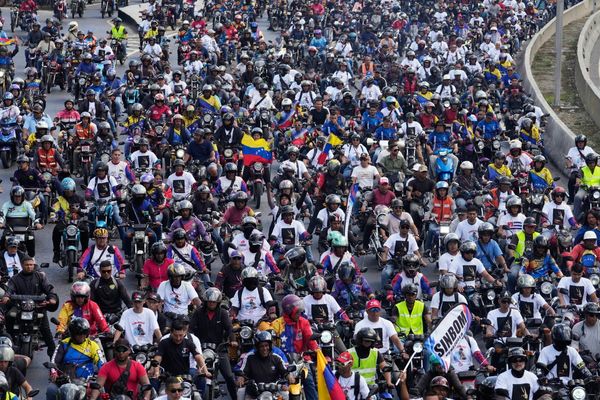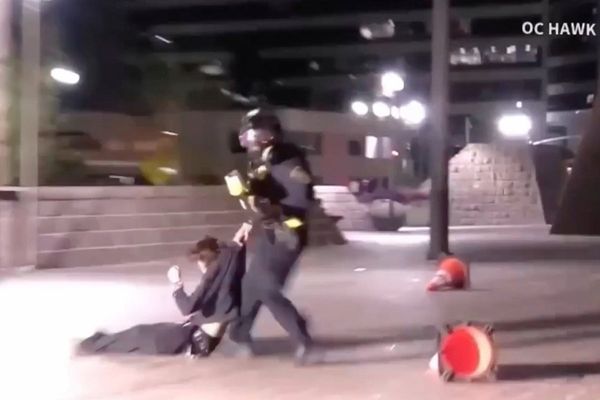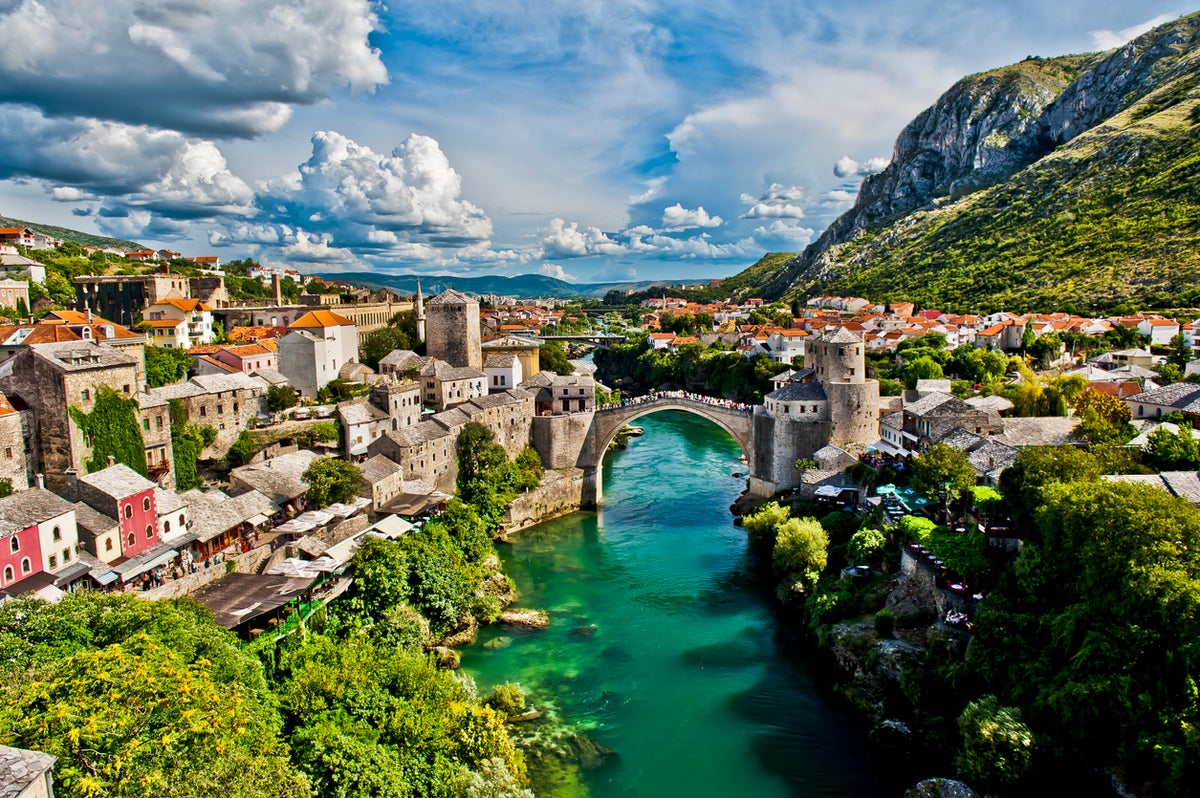
It was the moment I looked past the brash local graffiti and spotted dozens of bullet holes shot through the walls that it hit home. Or was it stumbling upon a cemetery with multiple thin, white grave markers emblazoned with the date “1993”, like skinny soldiers standing to attention? Either way, it took a trip to the Balkans to fully appreciate the impact of the Yugoslav Wars of Independence, which took place just 30 years ago.
These traces of conflict caught my attention in Mostar, Bosnia and Herzegovina, at the end of a 16-night rail tour through the Balkan region, coloured by its struggles for independence following the death of dictator Tito, and the collapse of the Republic of Yugoslavia. Suddenly, they seemed starkly recent.
I’d joined a tour group of history-curious travellers, chugging our way through seven nations that made up the former Yugoslavia. Slovenia, Croatia, Bosnia and Herzegovina, Montenegro, Serbia, Kosovo and North Macedonia – you probably know the names, but have likely only visited the most holiday-marketed, Croatia, or perhaps Slovenia if you’re a trendsetter. In a bid to lower my carbon footprint, I’d joined this overland trip to these mostly untrodden lands, where we’d travel solely by rail, bus and even local trams.
Not only was it far kinder to the planet to zip between stops on public transport; it gave our tour group the chance to savour the scenery and learn more about the culture along the way. Our key to understanding the Balkans was our guide, Jane (pronounced Yaneh), who introduced us to these under-the-radar countries, where lively conversation – often about football or politics – along with copious coffee drinking was a favourite way to spend time.
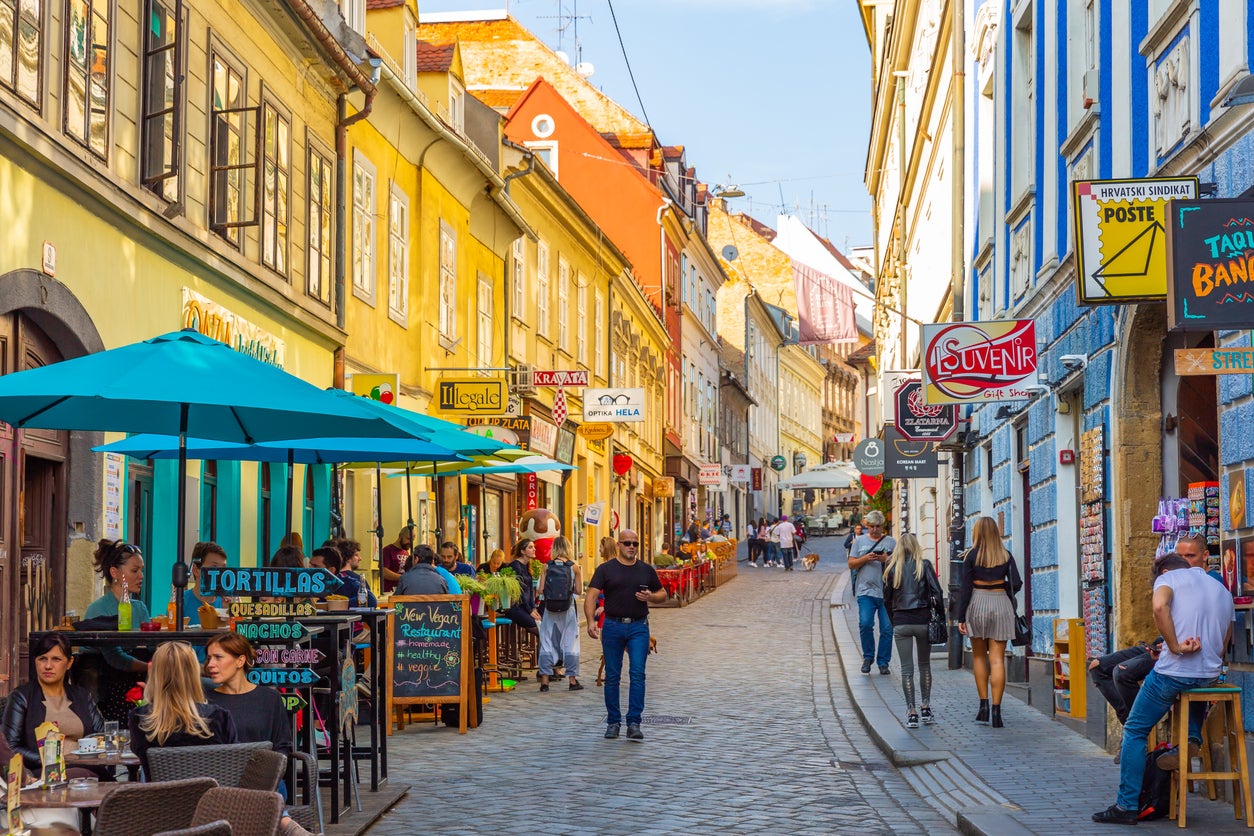
Fifteen of us assembled in Ljubljana, Slovenia for the start of the tour. There was a range of ages, with plenty of older travellers and several solo members in the mix. After a brief orientation tour by a local guide, Ute, we were free to explore the lovely Slovenian capital, a bijou city with an attractive old town and a variety of shops and cafes. Strolling through the beautiful Romanesque market, skirted by the fast-flowing River Ljubljanica, I spotted clever farmers cutting out the supermarket middle man by setting up vending machines, selling their milk directly to locals with their own containers.
We zipped on to Zagreb, Croatia, our first journey by train. On arrival, we celebrated with dinner at an excellent fish restaurant, Ribice i Tri Točkice. Appropriately for this pack of rail fans, we were booked into a hotel named for the Orient Express, with the Croatian Railway Museum just behind us.
A likely herald of climate change was the 78 metre high gushing waterfall being reduced to a trickle, a shadow of its former self
After a great night’s sleep, we woke for a walking tour of the historic Croatian capital, with its impressive food market, imposing cathedral and, at the city’s Upper Town, a memorial to those who lost their lives during the Medieval witch trials. That afternoon we ventured out to the stunning Plitviče Lakes with their incredibly clear, azure-coloured waters. A likely herald of climate change was the 78 metre high gushing waterfall being reduced to a trickle, a shadow of its former self, according to a tour group member who had visited before.
Our next train took us onward for an overnight stay in the capital city of Montenegro, Podgorica, a busy city stacked high with the development of new shopping malls and restaurants, mainly due to Russian investment. That evening we ate at the nearby traditional restaurant Rostilj Beli, our first taste of proper Balkan goulash.
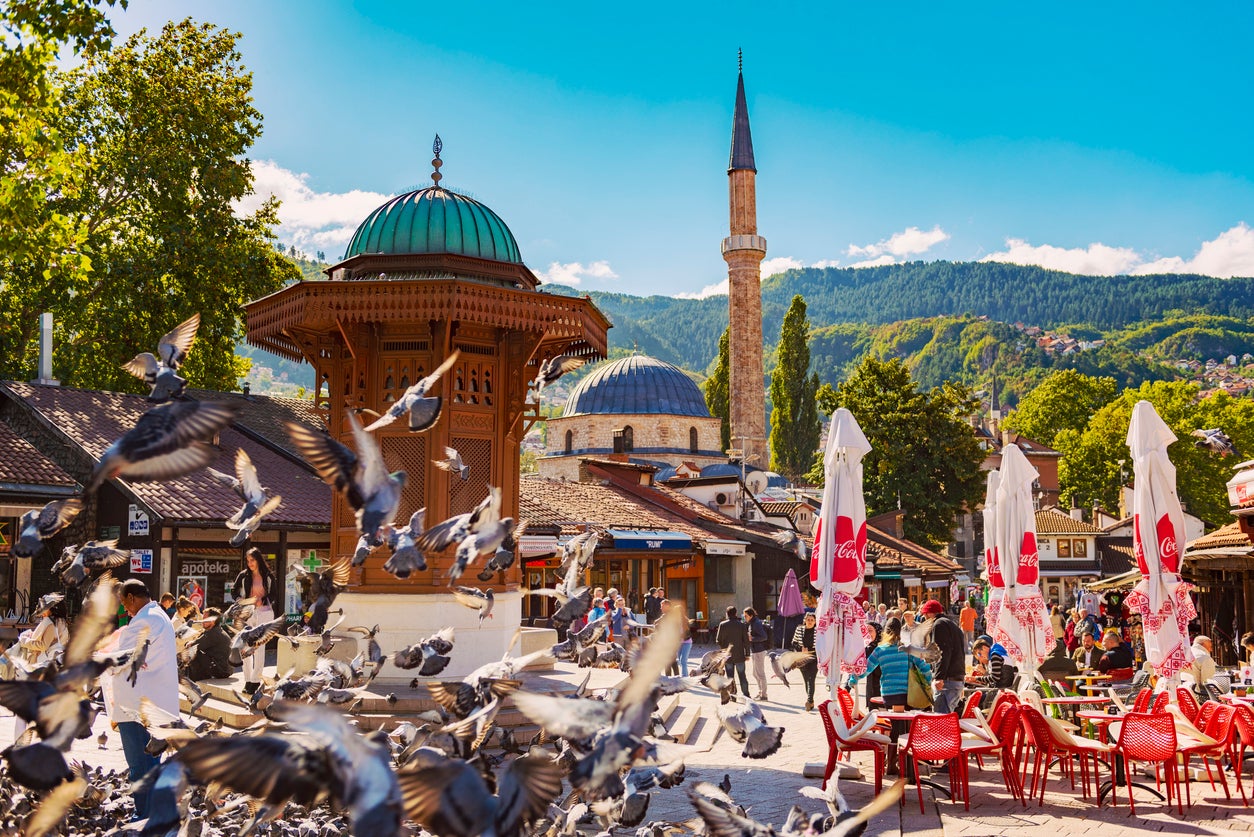
Then, a hitch: we should have been taking a train across the Kučka Korita mountain range, well into Serbia, to reach Belgrade. But the Montenegrin section of the rail link was unexpectedly closed; Jane determined that we would drive to the Serbian border and then catch the city train to Belgrade. Though a detour, it was no less lovely: driving the Adriatic Highway meant traversing stunning peaks and rough-hewn tunnels, opening out to arresting views of autumnal-coloured valleys streaked with early morning fog. I even spotted a farmer leading a tiny herd of dairy cows to high pastures.
Following a brief coffee stop at a lovely Alpine-style hotel on route, we arrived at the Serbian border and Prijepoljie station. The city train we now boarded near the confluence of the Lim and Milesevka Rivers was nearly empty, but that would change during the seven-hour journey to Belgrade, as the carriages slowly filled up.
I got chatting to a gaggle of youngsters sitting across from me. Their English was excellent, picked up effortlessly from TV and YouTube. We talked about the West, which they said teachers and elders reported to be “evil”. I sensed they were saying this for impact rather than it being accurate, but they were earnest when saying that NATO is considered the aggressor in the Ukrainian War. Most unexpectedly, they showed me how to bribe the conductor so as to pay a fraction of the train fare. “Everyone in Serbia does this!” chimes in the girl sitting opposite, noticing my shock.
Driving the Adriatic Highway meant traversing stunning peaks and rough-hewn tunnels, opening out to arresting views of autumnal-coloured valleys streaked with early morning fog
After breakfast in Belgrade, I snooped around the neighbourhood, spotting a patchwork of architectural styles. The gorgeous Russian-Secession-style Moskva Hotel was just around the corner, close to newsstands covered with newspapers and magazines featuring bold headlines and pictures of Putin.
Jane made sure we dined out in restaurants populated by locals, some with live music; several stops had tiny orchestras which might prompt folk dancing to spontaneously erupt. We loved his titbits of cultural insight: early on, Jane warned the vegetarians in the group that, particularly in Serbia, they might be referred to as “devil worshippers”.
“Don’t take it personally,” he winked. He also introduced us to rakija, the fiery local grain spirit, but advised not to have too much in order to avoid “eyes turning to negative signs.”
The next morning, we caught the high speed FALCON from Belgrade’s main station for a 30-minute ride to Novi Sad, Serbia’s second city and Europe’s City of Culture for 2022. An under-radar stop, it held a beautiful cathedral festooned with a zig-zag patterned roof, not to mention delectable gelato from several cute parlours. We whooshed onward to Bosnia-Herzegovina and the city of Sarajevo, then Mostar, places I might not have flown to directly for a dedicated city break, but ones I was delighted to explore on this comfy, train-led journey.
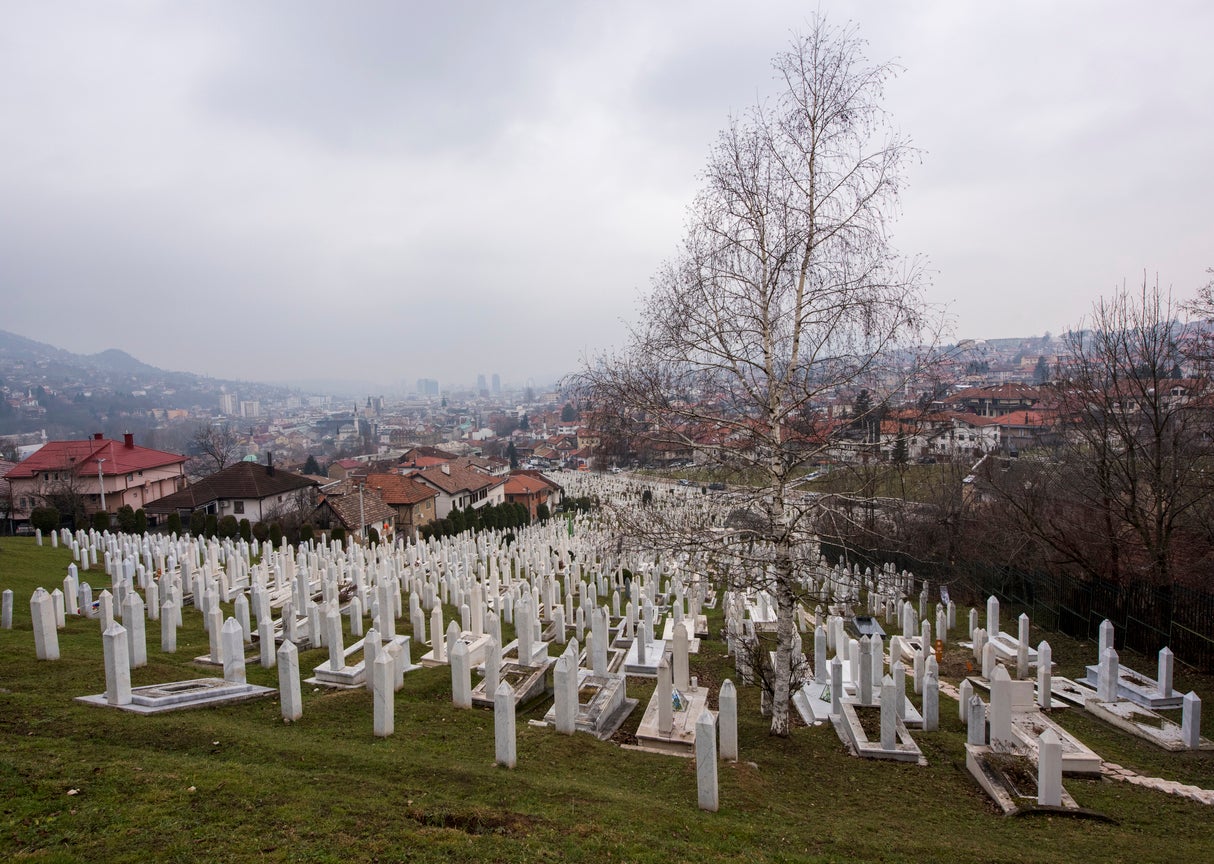
Sarajevo remains most famous for being the place where Archduke Franz Ferdinand was shot, lighting the touchpaper for the outbreak of WWI. It also held a successful 1984 Winter Olympics, but less than a decade later, was under siege during the Bosnian Inter-Ethnic War of 1992-1995. One of the most fascinating sights is its Tunnel Museum, where visitors can walk through part of a vast undergroup tunnel. In its entirety, it measured 960 metres in length and was 1.5 metres tall, providing a lifeline and a conduit for those trapped in the city for 44 months.
On the train to Mostar, Jane pointed out the village of Kojnic, where Tito’s nuclear bunker was recently discovered. It’s now open to visitors, he said, and is proving popular with Slovenians. As our rail journeys took us further east, I noticed the villages whizzing by graveyards adorned with white markers. But it was in our final stop, Mostar, that I finally visited one.
With free time to explore on my own, I discovered a beautifully maintained Muslim cemetery only steps from the old town. Many of the sad white tombstones were entwined with flowers and fixed with photos of young men. As I traced the pocked bullet holes in the walls nearby, it was Mostar that brought home the enormous number of casualties from the war, and the staggering youth of those who lost their lives.
As I traced the pocked bullet holes in the walls nearby, it was Mostar that brought home the enormous number of casualties from the war, and the staggering youth of those who lost their lives
Feeling sombre, I found myself drawn back to Stari Most, Mostar’s quaint “Old Bridge”, rebuilt after the war and an outstanding example of Balkan Islamic architecture. To add to the history, I quickly realised a centuries-old tradition was to take place: a young man was readying to leap off the bridge into the fast-flowing and freezing Neretva River. Jane had told us the story of the first ever jumper, who is said to have dived off the bridge to retrieve a silver coin tossed in by a nobleman. Money is still the motivation for the divers – though now it is tourists that donate the coin.
Understanding this area’s troubled past is only part of the Balkan story, I realised. It’s an area rich with tradition and culture, distincitve to each individual country, region and even city. Working my way through on the more contemplative scenic route, I’d seen a complex, warm and fascinating society. Part of me would remain there long after I’d left.
Travel essentials
Explore’s 16-day Balkans Rail Adventure travels through the countries of Slovenia, Croatia, Bosnia and Herzegovina, Montenegro, Serbia, Kosovo and North Macedonia by train. Priced from £2,130 per person, it includes 15 nights’ hotel accommodation along the route with breakfast, some additional meals, and a local Explore leader throughout.



